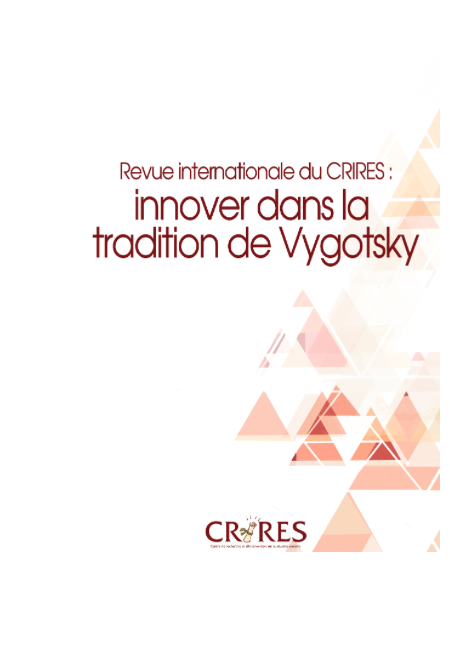Activités créatives et sociales dans Minecraft: comment un jeu vidéo est mobilisé dans une démarche sociale d'alphabétisation numérique
DOI :
https://doi.org/10.51657/975h8654Mots-clés :
objets numériques, les pairs, jeux numériques, culture numériqueRésumé
Bien que l'intérêt pour la culture numérique des enfants dans l'éducation de la petite enfance soit en hausse, la recherche a jusqu'à présent accordé une attention limitée à leur culture numérique dans des contextes informels. Notre question de recherche est la suivante : quelles sont les implications sociales et en termes de littératie numérique de l'activité informelle des enfants dans les jeux numériques ? En nous inspirant de la théorisation socio-matérielle ainsi que du travail de Rogoff (2014), nous explorons l'activité sociale de création dans les environnements virtuels. Dans notre étude de cas, nous identifions deux dimensions principales : les ressources pour créer des objets numériques et le statut social des objets numériques. L'interaction entre le monde matériel et virtuel révèle la richesse des dialogues entre les acteurs et les objets, à la fois à l'intérieur et à l'extérieur des jeux, suggérant de nouveaux modes de jeu et d'engagement avec la réalité.
Références
Clapp, E. P., Ross, J., Ryan, J. O., & Tishman, S. (2016). Maker-centered learning: Empowering young people to shape their worlds. John Wiley & Sons. https://pz.harvard.edu/resources/maker-centered-learning-empowering-young-people-to-shape-their-worlds
Culpepper, M. K., & Gauntlett, D. (2020). Making and learning together: Where the maker space mindset meets platforms for creativity. Global Studies of Childhood, 10(3), 264-274. https://doi.org/10.1177/2043610620941868
De Freitas, E., & Palmer, A. (2016). How scientific concepts come to matter in early childhood curriculum: Rethinking the concept of force. Cultural Studies of Science Education, 11(4), 1201-1222. https://doi.org/10.1007/s11422-014-9652-6
Dezuanni, M. (2020). "Minecraft' worldness' in Family Life." The Routledge Handbook of Digital Literacies in Early Childhood. 1st ed. Routledge. 366-376.
Deuze, M. (2012). Media Life. Polity.
Driver, R. (1989). Students' Conceptions and the Learning of Science. International Journal of Science Education 11(5), 481-490. https://doi.org/10.1080/0950069890110501
Hewett, K. J., Zeng, G., & Pletcher, B. C. (2020). The acquisition of 21st-century skills through video games: Minecraft design process models and their web of class roles. Simulation & Gaming, 51(3), 336-364. https://doi.org/10.1177/1046878120904976
Klein, G., Moon B., Hoffman, R.F. (2006). Making sense of sense-making: Alternative perspectives. IEEE Intelligent Systems 21(4), 70–73.
Kumpulainen, K., Gillen, J. (2017). A review of literature on young children's digital literacy practices in the home. https://digiliteymethodscorner.files.wordpress.com/2018/10/wg1-kumpulainen_gillen_lit-review-2017.pdf
Kajamaa, A., & Kumpulainen, K. (2019). Agency in the making: analyzing students' transformative agency in a school-based maker space. Mind, Culture, and Activity, 26(3), 266-281. https://doi.org/10.1080/10749039.2019.1647547
Kumpulainen, K., & Kajamaa, A. (2020). Sociomaterial movements of students' engagement in a school's maker space. British Journal of Educational Technology, 51(4), 1292-1307. https://doi.org/10.1111/bjet.12932
Law, N., Woo, D., de la Torre, J., & Wong, G. (2018). A global framework of reference on digital literacy skills for indicator 4.4.2. UNESCO Institute for Statistics. http://uis.unesco.org/sites/default/files/documents/ip51-global-framework-reference-digital-literacy-skills-2018-en.pdf
Mayring, P. (2014). Qualitative content analysis: theoretical foundation, basic procedures and software solution. Klagenfurt, 2014. URN: http://nbn-resolving.de/urn:nbn:de:0168-ssoar-395173
Mehto, V., Riikonen, S., Hakkarainen, K., Kangas, K., et Seitamaa‐Hakkarainen, P. (2020). Epistemic roles of materiality within a collaborative invention project at a secondary school. British Journal of Educational Technology, 51(4), 1246-1261. http://dx.doi.org/10.1111/bjet.12942
Nebel, S., Schneider, S., & Rey, G. D. (2016). Mining learning and crafting scientific experiments: a literature review on the use of Minecraft in education and research. Journal of Educational Technology & Society, 19(2), 355-366. https://www.jstor.org/stable/jeductechsoci.19.2.355
Niiranen, S. (2021). The learning-by-doing approach supports the development of students' technological understanding in craft and technology education. International Journal of Technology and Design Education, 31(1), 81-93. https://doi.org/10.1007/s10798-019-09546-0
Paavola, S., et Miettinen, R. (2019). Dynamics of design collaboration: BIM models as intermediary digital objects. Computer supported cooperative work, 28(1), 1-23. http://dx.doi.org/10.1007/s10606-018-9306-4
Pettersen, K., Arnseth, H. C., & Silseth, K. (2022). Playing Minecraft: Young children's postdigital play. Journal of Early Childhood Literacy. https://doi.org/14687984221118977.
Rogoff, B. (2003). The cultural nature of human development. Oxford university press.
Rogoff, B. (2014). Learning by observing and pitching in to family and community endeavors: An orientation. Human development, 57(2-3), 69-81.
Riikonen, S. M., Kangas, K., Kokko, S., Korhonen, T., Hakkarainen, K., et Seitamaa-Hakkarainen, P. (2020). The Development of Pedagogical Infrastructures in Three Cycles of Maker-Ceb ntered Learning Projects. Design and Technology Education, 25(2), 29-49.
Rivero, E., & Gutiérrez, K. (2022). Children Learning by Observing and Pitching In to community endeavours in online gaming communities. Journal for the Study of Education and Development, 1-10.
Sairanen, H., Kumpulainen, K. & Kajamaa, A. (2022) An investigation into children's agency: children's initiatives and practitioners' responses in Finnish early childhood education. Early Child Development and Care, 192(1), 112-123. https://doi.org/10.1080/03004430.2020.1739030
Sheridan, K., Halverson, E. R., Litts, B., Brahms, L., Jacobs-Priebe, L., & Owens, T. (2014). Learning in the making: A comparative case study of three makerspaces. Harvard Educational Review, 84(4), 505-531
Streeck, J., Goodwin, C., & LeBaron, C. (Eds.). (2011). Embodied interaction: Language and body in the material world. Cambridge University Press.
Valkonen, S., Kupiainen, R., & Dezuanni, M. (2020). Constructing social participation around digital making: A Case study of multiliteracy learning in a Finnish day care center. Journal of Early Childhood Education Research, 9(2), 477-497.
von Glaserfeld, E. (1989). Cognition, Construction of Knowledge, and Teaching in History, Philosophy, and Science Teaching. Synthese (Dordrecht) 80(1), 121-140.
Téléchargements
Publié
Numéro
Rubrique
Licence
© Maria Antonietta Impedovo 2024

Cette œuvre est sous licence Creative Commons Attribution - Pas d'Utilisation Commerciale - Pas de Modification 4.0 International.

